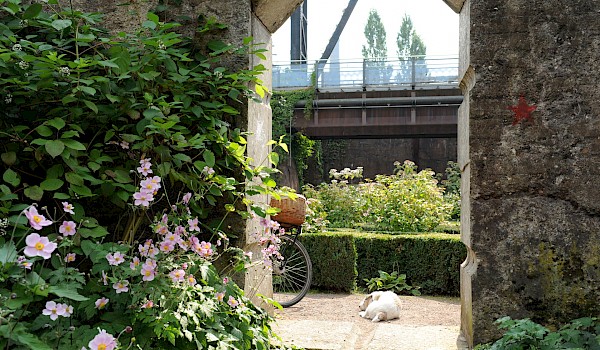Industrial nature
Surely nobody would have thought, even just a few decades ago, that disused industrial works would one day be numbered amongst the richest living spaces in heavily populated areas. And yet the site of the Landschaftspark which once saw a rapid change from agriculture to industry, has, since the closure of the works, seen nature take over again and revitalise the area.
The trees play a special role. From the plane trees by the car parks to the rows of poplars by the Clear Water Canal and the black locust trees by the park promenades, the trees have claimed back for themselves a major part of the Landschaftspark. The colourful mix of the ornamental blossom trees by the park entrance can be seen as a distinctive symbol of the Landschaftspark.
In addition the park is home to lots of species of plants which have travelled here with the iron ore and created for themselves a new place to live – globalisation, but of a rather different sort. But the park offers a home not only to plants, but also to lots of animals. And so the Landschaftspark with its site comprising almost 180 hectares has become a modern symbol for post-industrial natural open spaces.
In addition to the most varied species of plants, lots of animal species have also found a natural habitat in the Landschaftspark. Rare and exotic plants attract ever more varied residents to the old ironworks. At the park live several species of bats, natterjack toads, around 100 species of beetles and more than 45 species of birds. Many of these animals are to be found, first and foremost, in the ‘wilderness’ which, after the closure of the ironworks, was able to develop without any interference into one of the most valuable biotopes in the Landschaftspark.
Today numerous species of birds, such as garden warbler and blackcap, willow tit and great tit, hedge sparrow, willow warbler, chiffchaff, icterine warbler and yellow wagtail, live and breed in the dense vegetation cover comprising black elders, common hawthorn, willow trees and blackberry bushes. Even the song of the nightingale has been heard here. And in the ‘wilderness’ nature also has priority over recreational use in order to continue to offer the animals an undisturbed habitat and sanctuary. And for this reason visitors are not allowed in the densely vegetated site.
For further information please contact the Biological Station at the Landschaftspark Duisburg-Nord.



